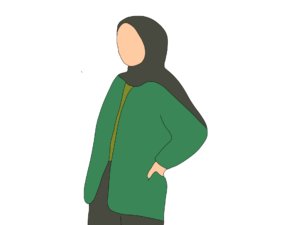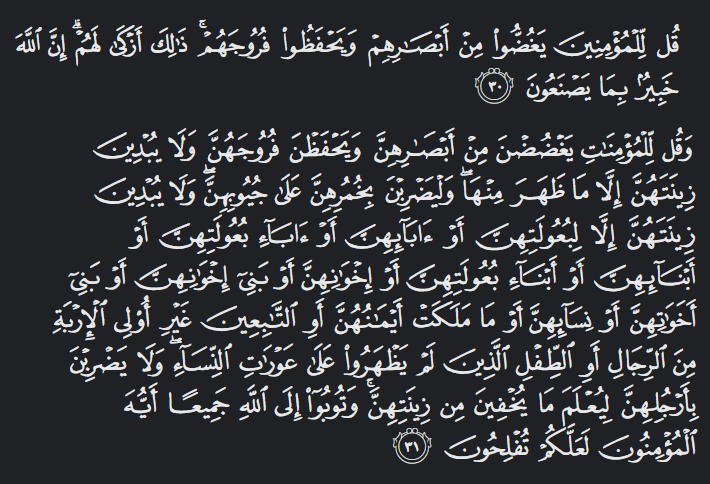Islam is not only a religion; rather, it is a life style. Despite the extravagance promoted in today’s media, Muslims ought to maintain a peaceful humble life. In fact, Islam seriously advocates modesty and promotes it in several aspects of life including dress code. This latter reflects the clothing rules followed by both women and men conforming to the rules of Islam.
Dress Code for Women in Islam:
Hijab is the term most frequently used in reference to covering for women. While it is generally used to refer to the scarf or outerwear worn by Muslim women, the word really means “cover” or “screen” in Arabic.

Hijab can be styled differently using scarves and large pieces of cloth to cover hair, neck and even shoulders at times. Other terms like nikab (or niqab) (a veil covering the face but leaves the eyes exposed), burka (covers the body from head to toe with a small veiled opening for the eyes), and chador (full-body cloak that leaves the face exposed) also refer to forms of covering for Muslim women.
After starting puberty, Muslim women are expected to cover awrah. They have to conceal the specifics of their hair and body from the public (amongst non-mahram men) by covering with loose, modest clothing; some Muslim women additionally choose to cover their faces and hands (like wearing nikab, burka, and chador).
Why do women differ in covering ?
Well, Muslim scholars hold different opinions about hijab; however, they all agree upon 6 basic clothing requirements which are the following:
- Women must cover their entire body, with the exception of their face and their hands up to the wrist. Nevertheless, these parts of the body can be covered, if wanted to.
- Clothing should be loose and cover the figure.
- Wearing transparent or see-through clothing is not appropriate.
- The attire should not be so flashy as to draw attention from the other sex.
- The attire should not be similar to that of the other sex.
- They should not dress in a manner that is similar to that of non-Muslims, i.e., they shouldn’t wear clothing that is specifically associated with or symbolic of other religions.
Contrary to the erroneous perception that Islam degrades women, women are told not to flaunt their beauty because Islam values them greatly. Allah (SWT) says: “O Prophet! Ask your wives, daughters, and believing women to draw their cloaks over their bodies. In this way it is more likely that they will be recognized ˹as virtuous˺ and not be harassed. And Allah is All-Forgiving, Most Merciful.1.” (Surah Al Ahzab verses 33:59)

Dress code for men in Islam
Men are no exception when it comes to promoting modesty in clothing. Men too are expected to dress humbly and abide by the rules of Islam. So what is the hijab version for men?

Unsurprisingly, men are not required to wear a certain type of cloth like hijab for women. Nonetheless, they are required to be dressed from navel to knee in loose, non-revealing clothing. After hitting puberty, men are also expected to fulfill the dress code requirements:
- Anything between the naval and the knee must be covered by clothing.
- Must be loose and opaque so that the intimate parts are concealed.
- The attire should not be similar to that of women.
- Wearing items of clothes that are exclusive to non-believers is not permitted.
- Men are not permitted to wear two types of ornaments, although women are. These are pure silk clothes and gold.
It is clear that Islam demands modest, simple, and dignified attire from both Muslim women and men. Now, how about Non- Muslims in Muslim lands?
What is expected from Non- Muslims to wear in Muslim countries?
Do Non- Muslims have to abide by the same rules imposed on Muslim women and Men? The answer is No. Non-Muslim women are not required to wear hijab simply because they are on Muslim lands. However, both women and men are encouraged to dress humbly in accordance with the Islamic dress code. They should dress appropriately and minimize exposing their bodies as much as possible. This would be considered a sign of respect for Islam which would only facilitate communication with Muslims and provide a better experience for the Non-Muslims.
What to wear in mosques?
It is best to wear simple and loose clothes. Long pants are preferable for men, while dresses with long sleeves or full-length skirts are preferable for women. Since Muslim women usually cover their heads, Non-Muslim women are encouraged to cover their heads too in the prayer hall.
Why do Muslims have a dress requirements?
Islamic chastity and modesty standards (known as haya) are what dictate the rules for the Islamic dress code. However, Islamic attire is just one example of modesty. A person must, above all else, act and speak modestly in public and maintain a humble demeanor. The clothing is only a reflection of one’s heart and mindset. It is one facet of their complete being. That is why all Muslims be it men or women must not only embrace the Islamic clothing rules but also the conduct that comes with it.
To conclude, all legitimate Muslim scholars throughout the history of Islam concur that both Muslim men and women have an obligation to adhere to the dress code’s standards. Any Muslim must portray the modesty much highlighted in Islam.
Making one’s conducts and actions such as clothing serve whatever Allah and his Messenger have established is one of the fundamental requirements of being a true believer according to the Quran.
Allah (SWT) says:
“And tell the believing men to lower their gaze and be modest. That is purer for them. Lo! Allah is aware of what they do. And tell the believing women to lower their gaze and be modest, and to display of their adornment only that which is apparent, and to draw their veils over their bosoms, and not to reveal their adornment save to [those relatives who fall within bounds of close relationship explained in the Qur’an]” Surah an-Nur, Verses 30-31.

